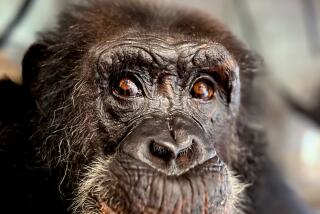Ex-Lab Chimp Dies After Brief Life of Liberty
He was never actually free. Yet when Spike, a laboratory research chimp from New York, was brought to the Wildlife Waystation in the Angeles National Forest in October, he came as close as he had ever come to a life of peace and liberty.
But Spike died of liver failure in November, about a month after his arrival at the Waystation with eight other ex-laboratory chimps.
Spike’s death deprived him of what would have been his first opportunity to live in open contact with other chimps.
His demise surprised and saddened those who cared for Spike, the youngest of the chimps brought to the refuge from New York University’s Laboratory for Experimental Medicine and Surgery in Primates. He died Nov. 25, two days shy of his 16th birthday.
Waystation founder Martine Colette revealed Spike’s death this week in a conversation about the status of the former lab chimps. Typically, chimps have a normal life span of 40 to 50 years, Colette said.
“It’s a tough one, for me, and for those at the Waystation,” said Dr. James Mahoney, deputy director of the NYU lab. “He never really had a chance to get settled and get to know anyone.”
Mahoney brought Spike into this world by performing a caesarean section on Spike’s mother. Spike’s mother died four days after giving birth, and Mahoney raised Spike in his own home for nine months.
The liver disease that killed Spike was not related to the lab tests performed on him, which were primarily test vaccinations for hepatitis B and C, Mahoney said. “It was a degenerative disease that also affected his kidneys,” and may have ultimately damaged his heart, too, the doctor said.
Veterinarians tried “everything they possibly could to save him,” including flying in chimp plasma from New York, Colette said.
Spike had three transfusions, which seemed to help, said Mahoney, who flew to California when Spike first became ill. After the transfusions, Mahoney went back to New York. But Spike’s condition deteriorated again. He died while asleep in his cage.
“This animal was a symbol to me,” Mahoney said. “He represented the plight of animals used in research. We owed him a better life.”
At the NYU lab, many chimps--social animals by nature--are held in separate cages to prevent disease from spreading. By retiring some lab chimps at Colette’s refuge, Mahoney had hoped to restore a modicum of comfort and relief to such animals.
Colette said she has begun the process of socializing five of the remaining eight NYU chimps, all of whom are in good health, according to Colette and Mahoney.
“It’s going very well,” she said. “We’re monitoring them closely, constantly changing the dynamics, seeing how they react to each other. It’s a very gradual process.”
If she can raise enough funds, Colette plans to build a new primatology center to house the ex-lab chimps, as well as three other chimps who live at the Waystation.
“It will be a wonderful place developed for chimps’ pleasures,” Colette said.
More to Read
Sign up for Essential California
The most important California stories and recommendations in your inbox every morning.
You may occasionally receive promotional content from the Los Angeles Times.










